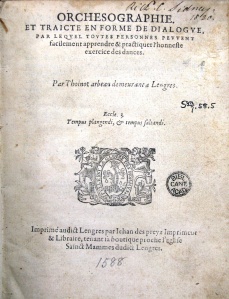The countdown to Christmas Day has begun and is marked each year by certain pre-Christmas traditions. One much-loved tradition in the Cambridge library community is the Entrance Hall carols sung by the Library choir. I am a member of this choir and I noticed during rehearsals that several of this year’s carols had interesting European origins which it might be worth delving into.

We sing each year from the University Carol Book edited by Erik Routley, first published in 1961. This contains some interesting annotations and footnotes. For Unto us is born a son we are told that it is a German carol and that the melody appeared in Piae Cantiones, a Finnish song book of 1582 (although Edgar Pettman, one of the contributors to the carol book, found earlier German manuscripts to examine and concluded that the original melody – which we sang this time – had been slightly different). Piae Cantiones contained 74 late medieval Latin songs, about half of which were Finnish/Swedish and about half originated in central Europe. It was published in Greifswald and edited by Jaako Suomalainen or Finno, a clergyman who was headmaster of the Cathedral School in Turku, southwest Finland. By the 19th century it was a rare book but in 1853 a copy came into the possession of John Mason Neale, a prominent Victorian hymn-writer, and he ensured that the book and songs from it became known in Britain. The University Library has a 1967 facsimile edition of Piae Cantiones (M250.d.95.67). You can also access a facsimile edition at http://www.spielleut.de/facs_piae_cantiones.htm.

The tune for Ding Dong! Merrily on high is from Branle de l’Official in Orchésographie, a work of 1588, so almost contemporary with Piae Cantiones. This was an instruction book of dance by Thoinot Arbeau, an anagrammatic pen-name of a priest called Jehan Tabourot. The book sets out dance steps alongside melodies so the music is presented vertically. Peter Warlock used some of the melodies from Orchésographie in his Capriol Suite. The University Library is fortunate to have two 16th century copies of Orchésographie (Rel.c.56.4 and Syn.7.58.5) as well as an English translation from 1967 (M806.c.95.10).

Stille Nacht is one of the most well-known Christmas carols and UNESCO added it to its list of intangible cultural heritage in 2011. Our rendition of the carol this year was exactly the same as the very first performance on Christmas Eve, 1818 in the church of Oberndorf, Austria with guitar accompanying male soloists and the choir repeating the last two lines in harmony. The male soloists in the first performance were Joseph Mohr, the village priest who had written the words a couple of years earlier, and Franz Gruber, the organist and schoolteacher in a nearby village, who wrote a melody for the words when Mohr asked him to on December 24th 1818. There are stories and myths surrounding this carol, none of which can be proved – you might like to believe that guitar was used because the church organ was not working; Mohr’s request to Gruber was certainly very short notice.
Three kings is perhaps the best known work in Britain of Peter Cornelius (1824-1874), a German composer and writer. He originally set his melody for solo voice over a piano version of the hymn tune Wie schön leuchtet der Morgenstern, written in 1597 by Philipp Nicolai. This original version is contained in Cornelius Album (M290.a.90.628). It was later reworked into an English anthem where the soloist is accompanied by a four-part choir singing the chorale tune which is the version we sang. Cornelius was the nephew of the painter Peter von Cornelius (1784-1867) and while staying with him in Berlin, he met prominent 19th century figures such as Alexander von Humboldt, the Brothers Grimm, Mendelssohn and Liszt. He was also friends with Wagner.
If you were unable to hear the UL carols this year you may be interested to watch this recording:
Here are the start times in the video both for the carols referred to above and for the others sung by the choir this year: Unto us is born a son: 0:00; Infant holy: 1:50; Ding Dong! merrily: 3:48; Stille Nacht: 6:14; God rest you merry: 10:15; Three kings: 12:40; Christmas is coming: 15:25.
If you would like to know more about the origins of Christmas carols, the following books may be helpful:
Christmas and its carols by Reginald Nettel (1960) M794.d.95.4
The English carol by Erik Routley (1958) M794.c.95.6
Christmas carols: from village green to church choir by Andrew Gant (2014) M794.d.201.2
Katharine Dicks





Fascinating. Thanks Katharine!
Article good – very interesting. Liked the singing Giles at Stratford-upon-Avon